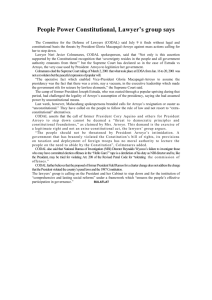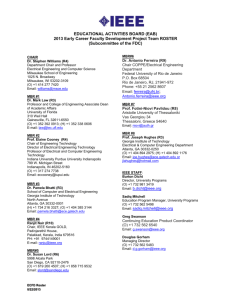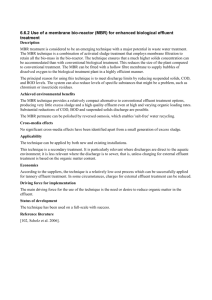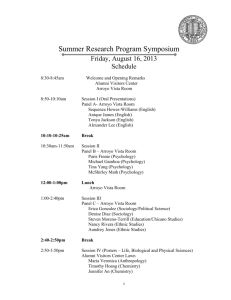PRE-MEETING FIELD TRIP: STRATIGRAPHY AND TECTONIC DEVELOPMENT OF THE
advertisement
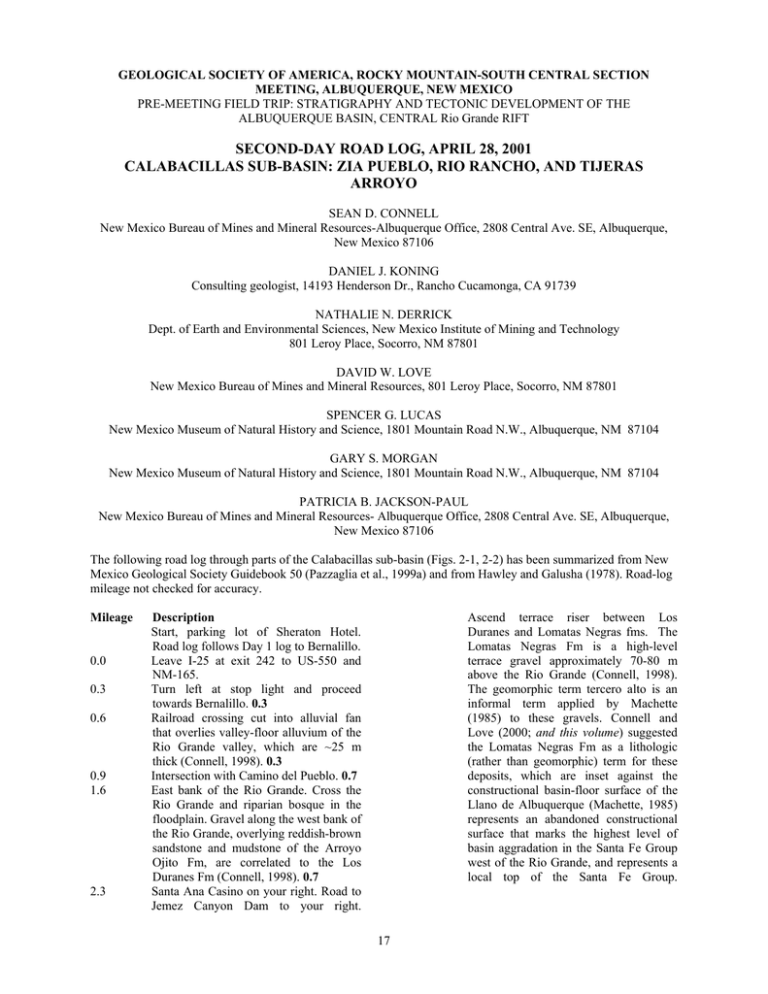
GEOLOGICAL SOCIETY OF AMERICA, ROCKY MOUNTAIN-SOUTH CENTRAL SECTION MEETING, ALBUQUERQUE, NEW MEXICO PRE-MEETING FIELD TRIP: STRATIGRAPHY AND TECTONIC DEVELOPMENT OF THE ALBUQUERQUE BASIN, CENTRAL Rio Grande RIFT SECOND-DAY ROAD LOG, APRIL 28, 2001 CALABACILLAS SUB-BASIN: ZIA PUEBLO, RIO RANCHO, AND TIJERAS ARROYO SEAN D. CONNELL New Mexico Bureau of Mines and Mineral Resources-Albuquerque Office, 2808 Central Ave. SE, Albuquerque, New Mexico 87106 DANIEL J. KONING Consulting geologist, 14193 Henderson Dr., Rancho Cucamonga, CA 91739 NATHALIE N. DERRICK Dept. of Earth and Environmental Sciences, New Mexico Institute of Mining and Technology 801 Leroy Place, Socorro, NM 87801 DAVID W. LOVE New Mexico Bureau of Mines and Mineral Resources, 801 Leroy Place, Socorro, NM 87801 SPENCER G. LUCAS New Mexico Museum of Natural History and Science, 1801 Mountain Road N.W., Albuquerque, NM 87104 GARY S. MORGAN New Mexico Museum of Natural History and Science, 1801 Mountain Road N.W., Albuquerque, NM 87104 PATRICIA B. JACKSON-PAUL New Mexico Bureau of Mines and Mineral Resources- Albuquerque Office, 2808 Central Ave. SE, Albuquerque, New Mexico 87106 The following road log through parts of the Calabacillas sub-basin (Figs. 2-1, 2-2) has been summarized from New Mexico Geological Society Guidebook 50 (Pazzaglia et al., 1999a) and from Hawley and Galusha (1978). Road-log mileage not checked for accuracy. Mileage 0.0 0.3 0.6 0.9 1.6 2.3 Ascend terrace riser between Los Duranes and Lomatas Negras fms. The Lomatas Negras Fm is a high-level terrace gravel approximately 70-80 m above the Rio Grande (Connell, 1998). The geomorphic term tercero alto is an informal term applied by Machette (1985) to these gravels. Connell and Love (2000; and this volume) suggested the Lomatas Negras Fm as a lithologic (rather than geomorphic) term for these deposits, which are inset against the constructional basin-floor surface of the Llano de Albuquerque (Machette, 1985) represents an abandoned constructional surface that marks the highest level of basin aggradation in the Santa Fe Group west of the Rio Grande, and represents a local top of the Santa Fe Group. Description Start, parking lot of Sheraton Hotel. Road log follows Day 1 log to Bernalillo. Leave I-25 at exit 242 to US-550 and NM-165. Turn left at stop light and proceed towards Bernalillo. 0.3 Railroad crossing cut into alluvial fan that overlies valley-floor alluvium of the Rio Grande valley, which are ~25 m thick (Connell, 1998). 0.3 Intersection with Camino del Pueblo. 0.7 East bank of the Rio Grande. Cross the Rio Grande and riparian bosque in the floodplain. Gravel along the west bank of the Rio Grande, overlying reddish-brown sandstone and mudstone of the Arroyo Ojito Fm, are correlated to the Los Duranes Fm (Connell, 1998). 0.7 Santa Ana Casino on your right. Road to Jemez Canyon Dam to your right. 17 NMBMMR OFR 454A Figure 2-1. Shaded-relief map of the Albuquerque area, illustrating the locations of stops for day 1 (black circles), and day 2 (white squares). Base prepared by S.D. Connell for Pazzaglia et al. (1999b). 18 NMBMMR OFR 454A Figure 2-2. Simplified geologic map of the NW margin of the Calabacillas sub-basin, illustrating the approximate location of stops 1-6. 2.6 3.1 4.1 4.5 6.6 To the south, correlative deposits contain the middle Pleistocene Lava Creek B ash (ca. 0.66 Ma; N. Dunbar, 2000, written commun., A. Sarna-Wojciki, 2001, written commun.). The maximum vertical extent of incision by the Rio Grande during the Pleistocene is approximately 100-200 m. 0.3 Intersection with NM-528. 0.5 Milepost 3. Ascend terrace riser between Los Duranes and Lomatas Negras fms. 1.0 Milepost 4. 0.4 Loma Barbon Mbr offset down-to-theeast by the Luce fault of Kelley (1977) in road cut to your right. 2.1 Badlands at 9:00 expose the Loma Barbon Mbr of the Arroyo Ojito Fm, which are capped by conglomeratic sand of the Ceja Mbr of the Arroyo Ojito Fm beneath the Llano de Albuquerque. Loma Barbon is low hill between 910:00. A volcanic ash exposed on a 7.1 19 ridge less than 2 km to the northeast yields a 40Ar/39Ar date (on sanidine) of 6.82±0.04 Ma (Connell, 1998) and is geochemically correlative to the Peralta Tuff Mbr of the Bearhead Rhyolite, exposed at Tent Rocks and Peralta Canyon in the western Santo Domingo sub-basin (N. Dunbar, oral commun., 2001). A number of lapilli and ash fall deposits in similar stratigraphic positions are exposed along the southern margin of the Rio Jemez valley. These tephra are dated between 6.8-7.4 Ma (W.C. McIntosh, 1998-2000, written commun.). Similar-aged fall deposits have not been recognized to the south in the Arroyo Ojito Fm, suggesting that these exposures may be near the southern limit of fallout from the Bearhead vents. 0.5 Milepost 7. Sierra Nacimiento at 11:00 and the eastern flank of the Ziana structure between 9:00 and 10:00. The Ziana structure is interpreted to be a NMBMMR OFR 454A 7.6 8.7 9.1 9.9 11.1 13.3 17.9 horst by Personius et al. (2000, see cross section), or an anticlinal accommodation zone (Stewart et al., 1998) that marks the boundary between the Calabacillas and Santo Domingo sub-basins. The southern flank of the Jemez Mts at 1:00-3:00. An angular unconformity between Quaternary alluvial deposits and dipping sediments of the Arroyo Ojito and Zia fms are visible. 0.5 Santa Ana Pueblo reservation boundary. Volcanic rocks and Santa Fe Group sediments are exposed at the southern flank of the Jemez Mts between 1-3:00. From left to right is Chamisa Mesa, capped by the 10.4±0.5 Ma basalt at Chamisa Mesa (K/Ar date in Luedke and Smith, 1978). The Chamisa Mesa basalt (Paliza Cyn Fm) overlies the Cerro Conejo and Chamisa Mesa Mbrs of the Zia Fm. Other late Miocene basaltic features of the Paliza Cyn Fm include Borrego Mesa, Pico Butte, and Bodega Butte. 1.1 White bed to your left is an ash correlated to one of the Trapper Creek tephra. 0.4 Cross valley incised into the Cerro Conejo Mbr with at least two prominent white ashes exposed between 9:00 and 10:00. The thicker ash bed has been geochemically correlated (A. SarnaWojcicki, written commun., 1999, 2001) to Snake River Plain/Yellowstone tephra from the Trapper Creek section of southern Idaho. Age estimate of the best match is 11.2±0.1 Ma and a weaker match to a higher tephra in the same section was correlated to tephra dated at 10.94±0.03 Ma by Perkins et al. (1998). The ~11 Ma age of this ash agrees well with the presence of the Clarendonian canid Epicyon, which was obtained near here (Lucas and Morgan, this volume; R.H. Tedford, 1999, oral commun.). 0.8 To your right, note outcrop of ledgy, cemented sandstone beds in the Cerro Conejo Mbr of the Zia Fm with oriented concretions (see Mozley and Davis, 1996; Beckner and Mozley, 1998). 1.2 Milepost 11. 2.2 Zia Pueblo reservation boundary. 2.2 Entrance to Zia Pueblo at 3:00. The Pueblo sits atop a middle Pleistocene terrace tread (Qt4 of Formento-Trigilio and Pazzaglia, 1998) north of the Rio Jemez. The western flank of the Rio Grande rift, eastern margin of the Colorado Plateau, and southern tip of the southern Rocky Mts. are between 11:00 and 3:00. The high peak at 2:00 is Pajarito Peak of the Sierra Nacimiento. Rio Jemez valley incised through an ignimbrite sheet of the upper Bandelier Tuff (ca. 1.2 Ma) and Permian sandstone at 3:00. The white cliffs between 12:00 and 1:00 are underlain by gypsum of the Todilto Fm, which is being quarried here. 1.0 18.9 Low hills to left are underlain by Chamisa Mesa Mbr of Zia Fm. 1.1 20.0 Approaching western boundary of the rift. Jurassic and Cretaceous rocks ahead. Jemez valley at 3:00. 1.0 21.0 Turn left onto Cabezon Rd. and stay straight, passing onto Zia Pueblo land. The following stop is on Zia Pueblo land. You must obtain permission to travel on Zia tribal lands from the Pueblo administration. 1.1 21.1 Bear right, stay on Cabezon Rd. Traveling on pre-rift rocks of the Colorado Plateau and San Juan Basin. Road traverses Jurassic strata of the Summerville and Todilto Fms to your right, and Brushy Basin Mbr of the Morrison Fm to your left. Cross northstriking, down-to-the-east San Ysidro fault (Woodward and Ruetschilling, 1976). To the north, it places Precambrian rocks against Neogene basin fill. To the south, it places Zia Fm against the Arroyo Ojito Fm. This fault shows evidence of Pliocene and possible early Quaternary displacement exposed along La Ceja, the southern margin of the Rio Puerco valley and northern limit of the Llano de Albuquerque. 1.4 22.5 Pass narrows through the Salt Wash Mbr of the Morrison Fm 1.5 24.0 Turn left on unmarked dirt road. 0.9 24.9 Gray cliffs on your left are Piedra Parada Mbr deposits of the Zia Fm overlying the Galisteo (Eocene) and Menefee (Cretaceous) fms. On your right is Cretaceous Mancos Shale. 1.1 26.0 Bear right. 0.5 26.5 Pull off road into field and park. Hike up hill to outcrop. STOP 1. The Zia Fm and base of syn-rift sediments. Cerro Conejo (formerly Sky Village NE) 7.5’ quadrangle, GPS: NAD 83, UTM Zone 013 S, N: 3,926,640 m; E: 334,515 m. The purpose of this stop is to observe the contact between pre- and syn-rift rocks and discuss the sedimentology, paleo-environmental, and structural setting of the Zia Fm. 20 NMBMMR OFR 454A We will examine exposures of the type Piedra Parada Mbr of the Zia Fm, which rests upon upper Galisteo Fm mudstone and conglomerate. The basal 0.5-3 m of the Zia section in Arroyo Piedra Parada contains fluviatile gravel composed mostly of rounded chert pebbles derived from Mesozoic rocks of the Colorado Plateau. Scattered within the gravel are cobbles of rounded, intermediate volcanic rocks (Fig. 2-2). Elsewhere, these cobbles form a discontinuous stone pavement, where many of the volcanic clasts have been sculpted by the wind into ventifacts (Tedford and Barghoorn, 1999; Gawne, 1981). Three volcanic clasts have been 40Ar/39Ar dated between 32 to 33 Ma (31.8±1.8 Ma, 33.03±0.22 Ma, 33.24±0.24 Ma, S.M. Cather, W.C. McIntosh, unpubl. data), indicating that they were once part of the middle Tertiary volcaniclastic succession. The dates alone are not sufficient to established correlation to possible Oligocene sources, such as the San Juan volcanic field, Mogollon-Datil volcanic field, or the Ortiz porphyry belt. The clasts could be derived from the now buried unit of Isleta #2 of Lozinsky (1994), which approaches 2.2 km thickness in oil-test wells about 25-30 km to the south. of Eocene ash flow tuffs and thick intervals of volcanic strata suggest the presence of volcanic centers under the basin. Thus, the unit of Isleta #2 could possibly be differentiated into a separate lithostratigraphic unit. The initiation of rift-basin subsidence, as indicated basal exposures of the Zia Fm, began in the early Miocene, as early as 19-21 Ma (Arikareean land mammal age) near this stop. Older strata, however, are encountered in the Davis Tamara #1-Y oil test, which was drilled on La Ceja to the west (see minipaper by Connell, Koning, and Derrick, this volume). In this well, approximately 455-481 m of pink to reddish-yellow sand underlie strata correlated to the Zia Fm. Precise correlation of these underlying deposits have not been made, but on the basis of stratigraphic position, they are possibly correlative to the unit of Isleta #2(?). The presence of this previously undescribed section near the type area of the Zia Fm suggests that deformation began during Oligocene, perhaps as block faulting or broad flexures. The Piedra Parada Mbr eolian facies exposed at this stop are typical of the lower Zia Fm (Fig. 2-3). The Piedra Parada Mbr is a pinkish-white, gray, and yellow, quartz-rich, cross-stratified fine- to coarsegrained eolian dune sandstone (Galusha, 1966) and minor muddy interdune sandstone (Gawne, 1981). Crossbed orientations indicate a S-SE transport direction (Gawne, 1981). The Piedra Parada Mbr is overlain by reddish- to yellowish-brown fluvial and sandstone, siltstone, and silty sandstone of the Chamisa Mesa Mbr, which is overlain by the Cerro Conejo Mbr (STOP 2). Turn around and return to US-550. 1.1 27.6 Bear right. 0.9 28.5 Cabezon Rd. intersection. Turn right and retrace route back to US-550. Turn right onto US-550. 2.9 31.4 Turn right onto Indian route SP784. Proceed through gate. The following stops are entirely on Zia Pueblo land. You must obtain permission to travel on Zia tribal lands from the Pueblo administration. 0.9 32.3 Cross under power line. The Chamisa Mesa Mbr of the Zia Fm is to your right (west). 0.6 32.9 Proceed straight ahead through left fork in road. 0.4 33.3 Bear left and descend into Arroyo Ojito (Cañada de Zia of Galusha, 1966). Turn right into arroyo and follow arroyo channel south. 1.0 34.3 Pass through gate and drive ahead 100 m to low lying exposure on your right. STOP 2. Cerro Conejo (formerly Sky Village NE) 7.5’ quadrangle, GPS: NAD 83, UTM Zone 013 S, N: 3,925,835 m; Figure 2-2. Fluvial gravel between contact between Galisteo Fm (below) and Piedra Parada Mbr of the Zia Fm (above). Unconformities associated with this conglomerate may represent about 10-14 m.y. of sediments. Note the Oligocene volcanic pebble near lens cap. Most of the gravel is composed of rounded and polished chert and quartzite derived from the Galisteo Fm and Oligocene rocks. Paleocurrent data suggest a general S-SE direction of paleoflow (Gawne, 1981) from the adjacent Colorado Plateau and San Juan Basin. The unit of Isleta #2 contains abundant quartz (Lozinsky, 1994) and is petrographically distinct from the quartz-poor Espinaso Fm (Kautz et al., 1981). The greater abundance of quartz suggests that this unit was laid down by streams draining the quartz-bearing sediments along the basin margin and/or the Ortiz-Espinaso volcanic field, San Juan volcanic field, or Mogollon-Datil field. The presence 21 NMBMMR OFR 454A E: 340,055 m. Contact between crossbedded eolian sandstone of the Chamisa Mesa Mbr and the pink tabular sandstone of the Cerro Conejo Mbr. (Connell et al., 1999) is a very pale-brown to pink and yellowish-red, ash-bearing, cliff-forming, moderately to well sorted very fine- to mediumgrained sandstone with variable proportions of thinto medium-bedded mudstone, muddy sandstone, and sparse scattered coarse-grained sandstone and granule gravel. The sandstone and muddy sandstone beds are tabular and thin to very thickly-bedded. These tabular beds contrast with the overlying lenticular beds of the Navajo Draw Mbr of the Arroyo Ojito Fm. The Cerro Conejo Mbr is interpreted to represent a transition between the lower, dominantly eolian environments of the Chamisa Mesa and Piedra Parada Mbrs of the Zia Fm and the overlying, fluvially dominated Arroyo Ojito Fm. The Cerro Conejo Mbr is correlative to Tedford and Barghoorn’s (1997) “unnamed member” of the Zia Fm. The contact between the Cerro Conejo and Chamisa Mesa Mbrs is fairly sharp and marks a change in depositional environment from mostly eolian dune sand to a more diverse environment containing sheet sands, dune sands, and local ponds and fluvial deposits. Cerro Conejo Mbr outcrops north of La Ceja (Rincones de Zia of Galusha, 1966) have been a prolific source of fossil mammal remains. The biostratigraphy of the unit indicates that these deposits range from the late Barstovian to Clarendonian land mammal ages (~16-9 Ma). Paleontology and magnetostratigraphy from the eastern margin of the Rio Puerco valley (Ceja del Rio Puerco) suggests the presence of a 1-1.5 m.y. hiatus in the Cerro Conejo section (Tedford and Barghoorn, 1999). The lower contact of the Cerro Conejo Mbr is placed at the lowest appearance of medium-bedded mudstone and presence of steeper slopes. The Cañada Pilares Mbr is missing here and the underlying Chamisa Mesa Mbr contains a late Hemingfordian fauna. The Rincon quarry (Galusha, 1966), a stratigraphically important fossil locality was thought to be near the middle of the Cerro Conejo type section (R.H. Tedford, oral commun., 1998); however, in late 1999, R.H. Tedford, S. Barghoorn, and S. Connell relocated the Rincon quarry using Ted Galusha’s field notes and projected it into the type section (Fig. 2-5). This projection indicates that the Rincon quarry is near the stratigraphic base of the Cerro Conejo Mbr. Thus, the base of the Cerro Conejo Mbr is middle Miocene (14-16 Ma) in age (Tedford and Barghoorn, 1999). The Cerro Conejo Mbr in the Cerro Conejo quadrangle contains sparse thin granule gravel beds. Similar strata north of the Rio Jemez contain a greater abundance of coarse-grained sediment (Chamberlin et al., 1999). 0.3 34.6 Take right fork in arroyo channel, proceed west. 0.3 Figure 2-3. Simplified composite stratigraphic section of the Zia Fm at Arroyo Piedra Parada and Arroyo Ojito (modified from Galusha, 1966; Gawne, 1981; Connell et al., 1999). Locations of major fossil localities (diamonds), tephra (x symbol), and stop locations (boxes) are noted. Scale in meters. Upper ashes (Trapper Creek) are not present in the Arroyo Ojito type section. The type section of the Cerro Conejo Mbr in the Cerro Conejo (formerly Sky Village NE) quadrangle 22 NMBMMR OFR 454A 34.9 STOP 3. Eolian sand in Cerro Conejo Mbr. Cerro Conejo (formerly Sky Village NE) 7.5’ quadrangle, GPS: NAD 83, UTM Zone 013 S, N: 3,925,220 m; E: 339,800 m. This stop will examine a cross-bedded eolian facies of the Cerro Conejo Member (unit 5 of Connell et al., 1999). This unit contains moderately to well sorted sorted, fine- to coarse-grained sandstone with high-angle cross stratification. Fresh surfaces commonly expose laminated to very thinly bedded sets of alternating fine-grained sands and coarser grained sands with normal and reverse grading. These alternating beds are interpreted to represent alternating grainflow and grainfall deposits (Fig. 24). Turn vehicles around and retrace route downstream. 0.2 35.1 Turn right into tributary arroyo. Proceed south. 0.4 35.5 Thin white bed to your right is a marker ash in unit 6 of the Cerro Conejo Mbr. 0.4 35.9 Prominent thin to medium grained, well bedded sandstone ledges of unit 7 (Connell et al., 1999) are around you. Tabular sands are locally cross bedded. 1.8 Figure 2-4. Cross-bedded eolian sandstone of unit 5 of the Cerro Conejo Mbr type section of Connell et al. (1999). 37.7 STOP 4. Navajo Draw Mbr of the Arroyo Ojito Fm. Cerro Conejo (formerly Sky Village NE) 7.5’ quadrangle, GPS: NAD 83, UTM Zone 013 S, N: 3,921,550 m; E: 339,855 m. The Navajo Draw Mbr is the lowest member of the Arroyo Ojito Fm, which conformably overlies the Cerro Conejo Mbr in Arroyo Ojito (Fig. 2-5). The contact between the Cerro Conejo and Navajo Draw Mbrs suggests a major change in the source and depositional style. The yellow color is probably derived from the abundant Mesozoic rocks from the adjacent Colorado Plateau. Clasts predominantly include intermediate and rhyolitic volcanic rocks (~60%) with lesser amounts of sandstone, and sparse red granite, petrified wood, and Pedernal chert. Bedding in the Navajo Draw Mbr is lenticular; mudstone beds are commonly thin and gravel fills channels generally less than 1 m deep. Paleocurrent observations on imbricated clasts indicate a southsoutheasterly direction of flow. These intermediate volcanic pebbles and cobbles are probably recycled from Oligocene rocks. The presence of these rather coarse-grained gravels in channels having S-SE paleoflow directions suggests that they are probably recycled from the San Juan volcanic field in the San Juan Basin. 23 NMBMMR OFR 454A Barbon Mbr is finer grained than its top, and upwardfining sequences are relatively common. Continuing upsection, conglomeratic beds increase in frequency, and clasts generally become larger upsection where it culminates with the coarse-grained Ceja Mbr and Pantadeleon fm. Muddy sandstone and sandstone are present in lenticular beds that extend a few to several tens of meters laterally. Gravel is composed of variable amounts of red granite (10% to over 50%) with lesser amounts of sandstone, Pedernal chert, red siltstone, and basalt. The member is approximately 198 m thick. Paleoflow observations, presence of upward-fining sequences, and the generally sandy to muddy character of this unit suggest deposition by meandering streams. The Loma Barbon Mbr progressively coarsens upsection, where it interfingers with coarse sand and gravel underlying La Ceja. These coarse-grained, rim-capping deposits are assigned to the Ceja Mbr of the Arroyo Ojito Fm. Relatively weak (Bk) buried soils become common near the top. Turn vehicles around and head north back down the arroyo. 3.6 42.0 Pass through the gate in the arroyo. 2.9 44.9 Exit through gate at intersection with US550. Turn right and head west. 10.9 55.8 Turn right on NW Corridor Rd. 1.1 56.9 Turn left on Unser Blvd., near entrance to the New Mexico National Guard Armory. A sample from a prominent ash bed 2.5 km to the north yielded a chemical fingerprint to ~10.8-11.3 Ma ash of the Trapper Creek section (Personius et al., 2000; Personius, 2001, written commun.; Sarna-Wojcicki, 19982001, written commun.). 1.1 58.0 The water tank of Rio Rancho Utilities No. 15 to your left. Rio Rancho Utilities 18 test well was drilled near this site. 1.8 59.8 Subdued hill of Loma Duran at 10:00. We are traversing extensive Quaternary eolian sand deposited over a fluvially dissected landscape of the valley of Arroyo de la Barranca. 1.6 61.4 Turn right onto Progress Blvd. and proceed to intersection with Rainbow Blvd. This road follows the drainage divide between Arroyo de la Barranca and Arroyo de los Montoyas. 2.7 64.1 Turn right onto Rainbow Blvd. 3.9 68.0 Turn right on unmarked dirt road (GPS: NAD 83, UTM Zone 013 S, N: 3,917,150 m; E: 339,185 m). 0.2 68.2 Turn right on unmarked dirt road (GPS: NAD 83, UTM Zone 013 S, N: 3,917,355 m; E: 339,280 m). 0.1 68.3 Cross Arroyo Pantadeleon. 0.8 69.1 Bear left and descend to fence. 0.8 Figure 2-5. Simplified composite stratigraphic section of the Arroyo Ojito Fm and Arroyo Ojito (modified from Connell et al., 1999). Locations of tephra localities (x symbols) and stop locations (boxes) are noted. Scale in meters. Figure is extension of composite stratigraphic section of Figure 2-3. The contact between the Navajo Draw and Cerro Conejo Mbrs is conformable in Arroyo Ojito, but is likely disconformable to the west, near the basin margin. Triangles denote upward-fining sequences and hachured lines denote buried soils. Return to vehicles and continue south. 1.0 37.8 Make left at arroyo intersection. 0.4 38.2 On your left there is the transition from yellow-brown Navajo Draw deposits to red-brown deposits of the Loma Barbon Mbr. 0.2 38.4 STOP 5: Loma Barbon Mbr. Cerro Conejo (formerly Sky Village NE) 7.5’ quadrangle, GPS: NAD 83, UTM Zone 013 S, N: 3,921,090 m; E: 340,615 m. The Loma Barbon Mbr is a reddish-yellow to brownish-yellow and very pale brow, sequence of cliff-forming, lenticular claystone, sandy mudstone, and clayey to silty sandstone, intercalated with minor sandy conglomerate. Generally, the base of the Loma 24 NMBMMR OFR 454A 69.9 STOP 6. La Ceja. Cerro Conejo (formerly Sky Village NE) 7.5’ quadrangle, GPS: NAD 83, UTM Zone 013 S, N: 3,919,215 m; E: 340,115 m. From the crest of La Ceja (Rincones de Zia of Galusha, 1966), the Santa Fe Group stratigraphic succession can be seen across the Jemez and Zia faults. This stop affords a view of the local and regional effects on sedimentation attributed to syntectonic movement on rift-margin faults. The Ceja Mbr (provisional correlation) contains light-brown scoured and lenticular cobble to boulder gravel that is interbedded with reddish-yellow to pink, muddy fine to medium-grained sand and sandy gravel. Gravels are composed of basalt, Pedernal chert, sandstone and variable amounts of red granite and foliated granite and gneiss. The upper contact of the Ceja Mbr at this locality is placed at a prominent soil with Stage III-V(?) petrocalcic (Bkm) horizons and just below sand and gravel containing rounded recycled calcic peds. The deposit is 10-17 m thick here. The Ceja Mbr is approximately 65-m thick at its type locality (Kelley, 1977), about 35 km to the southwest. These differences in thickness are attributed to syntectonic influences on deposition. The presence of several calcic soils throughout the Ceja Mbr mark the beginning of episodic deposition in this part of the basin. A very thin light-brown sandstone and sandy pebble conglomerate of the Pantadeleon fm unconformably overlies the Arroyo Ojito Fm here. The deposit here <1 m thick and contains reworked calcic peds from the underlying strongly developed soil. The Pantadeleon fm at the Zia fault is coarse grained and was probably deposited by south-flowing streams flowing subparallel to the strike of the fault. A lens of white, fine-grained volcanic ash near the top of the Pantadeleon fm (Fig. 2-6) has been geochemically correlated to the 3.28 Ma Nomlaki Tuff of the Tuscan and Tehama fms in eastern California (A. Sarna-Wojciki, written commun., 1998). The age of this ash indicates that the Pantadeleon fm is temporally equivalent to the Ceja Mbr mapped to the south on the Isleta Reservation where it is associated with the 3.00 Ma Cat Mesa basalt flow (Maldonado et al., 1999). This age relationship suggests that the Pantadeleon fm may be correlative to the Ceja Mbr and that the underlying sediments may be a another coarse-grained heterolithic member of the Arroyo Ojito Fm. Additional study will be needed to differentiate and correlate the uppermost units of the Arroyo Ojito Fm and deposits on the Llano de Albuquerque. Turn vehicles around and retrace route south along Rainbow Blvd. 0.8 70.7 Intersection with road, bear right. 0.8 71.5 Turn left. 0.3 Figure 2-6. Exposures on hanging wall of Zia fault along La Ceja, looking to the ESE. A lens of ash correlated to the Nomlaki Tuff is just right of the symbol “NT.” 71.8 75.6 76.3 77.9 78.5 78.9 79.6 79.8 Turn left onto Rainbow Blvd. 3.8 Cross Progress Blvd. 0.7 Cross under power lines. 1.6 Cross over cattle gate and 28th Ave. 0.6 Cross Arroyo de Las Montoyas. 1.4 Turn right. 0.7 Turn left. 0.2 STOP 7: Pliocene pumice west of Rainbow Rd. Loma Machete 7.5’ quadrangle, GPS: NAD 83, UTM Zone 013 S, N: 3,906,740 m; E: 341,360 m. Note scattered lenses of pebble pumice conglomerate exposed in dirt roads. Pumice conglomerates are recognized as scattered lenses beneath the Llano de Albuquerque surface, which is just to the south and a few meters upsection. Some of these pumice pebbles are geochemically correlative to pumice in the unit overlying the strongly developed soil at STOP 6 and to pumice pebbles recognized near the top of the correlative Arroyo Ojito Fm deposits on the Isleta Pueblo. One of these pumice pebbles was dated at 3.01 Ma (Maldonado et al., 1999). Walk south up hill to a surface on the Llano de Albuquerque. There are a number of degraded fault scarps in the Rio Rancho area. Many of these faults can be mapped using aeromagnetic techniques (see reprinted paper by Grauch, 1999). Continue east on dirt road. 0.7 80.5 Turn right on Rainbow Blvd, heading south. 0.8 81.3 Intersection with Northern Blvd. Stay on Rainbow south. Begin paved road. 2.3 Alternate route: Take Northern Blvd. East to NM-528. Turn right (south) and take NM-528 (becomes Coors Blvd. in Albuquerque). Turn left onto eastbound onramp to Paseo del Norte. Drive east on Paseo del Norte, cross the Rio Grande, and turn right onto the southbound onramp to I-25. Drive south on I-25 until you reach Rio Bravo Blvd., where you will resume following the road log at mileage 109.1 25 NMBMMR OFR 454A 83.6 84.3 85.8 88.1 89.1 89.8 90.2 91.1 91.8 94.0 96.2 97.8 101.4 109.1 109.3 109.8 110.0 110.1 Left on Southern Blvd. Ascend westtilted dip slope of Llano de Albuquerque soil. 0.7 Baltic Ave. On your left is the white Llano de Albuquerque soil exposed. This is the eastern most exposure of the Llano de Albuquerque. Descend across fault that marks the easternmost exposure of strongly developed calcic soils associated with the Llano de Albuquerque surface. 1.5 Turn right on Unser Blvd., head south. 2.3 At the stop sign at the intersection of Unser Blvd. and Bandelier, turn left onto Bandelier. Descend into Calabacillas Arroyo. The cliff-forming basalt flows are from the ~156 ka Albuquerque volcanoes. 1.0 Stop sign. Turn right on McMahon Blvd. 0.7 Stop light. Turn right on Golf Course Rd. Poorly exposed low hills to your right contain rounded gravels of the Lomatas Negras Fm. 0.4 Cross Irving Blvd. To the west are shallow monitoring well that encounter Albuquerque volcanoes basalt, overlain by the Los Duranes Fm. 0.9 Cross Paradise Rd. and merge into left lane. At 1:00 is a flat-topped hill capped by basalt the Albuquerque volcanoes. 0.7 Left on Paseo del Norte. 2.2 Cross the Rio Grande. 2.2 Cross Edith Blvd. Edith Fm exposed under power line poles. Ascend valley border fans. 1.6 Turn right onto the I-25 South onramp. Bear left to stay in onramp lane and merge onto I-25. 3.6 Montgomery/Moñtano Blvd. overpass. 7.7 Take Rio Bravo Blvd. exit. 0.2 Turn right on Rio Bravo Blvd. 0.5 Turn left on Broadway. 0.2 Turn left and enter gravel quarry through locked gate. You must get permission from quarry operator prior to entering quarry. 0.1 STOP 8. Albuquerque West 7.5’ quadrangle, GPS: NAD 83, UTM Zone 013 S, N: 3,875,400 m; E: 345,000 m. Gravel quarry near mouth of Tijeras Arroyo. Walk to northern margin of Tijeras Arroyo along Railroad tracks. Tijeras Arroyo was cut by Tijeras Creek during latest Pleistocene time and has since filled with ~80 ft of sand and muddy sand. The walls of Tijeras Arroyo have yielded numerous fossil localities of medial Blancan (late Pliocene) mammals in deposits correlated to the Arroyo Ojito Fm (probably Ceja Mbr based on stratigraphic position). Stratigraphic sections at this site were measured and described by Lambert (1968) and later re-measured by Lucas et al. (1993). Lambert (1968) and Lucas et al. (1993) report the presence of pumice in the lower part of this section (unit 3 of Lucas et al., 1993). In situ pumice was not readily observed low in the section, however, the presence of Pliocene pumice pebbles near the top of the Arroyo Ojito Fm in Rio Rancho (STOP 7) and the western part of the Isleta Reservation suggests that these stratigraphically lower pumice clasts might be Pliocene in age and correlative to some of the STOP 7 pumice beds. As you walk up this section, note that the gravel contains red granite, sandstone, Pedernal chert, basalt, small rounded quartzite pebbles, and polished brownish-yellow chert. Geologic mapping and preliminary results of gravel and sand petrography indicate that the lower part of this succession is correlative to the Arroyo Ojito Fm. Deposits of the Arroyo Ojito Fm are overlain by pumice-bearing sand and gravelly sand deposits of the ancestral Rio Grande. Tephra in this upper succession are correlated to the early Pleistocene Bandelier Tuff and Cerro Toledo Rhyolite (Jemez volcanic field) and were laid down by the ancestral Rio Grande during early Pleistocene times. These upper deposits contain early Irvingtonian (early Pleistocene) mammals and plants. The ancestral Rio Grande deposits contain more abundant rounded quartzite than the underlying deposits. An ash dated at 1.26 Ma is several meters below the top of the ancestral Rio Grande section in an exposure along the southern margin of Tijeras Arroyo. An ash correlated to the ca. 0.66 Ma Lava Creek B (N. Dunbar, 2000, oral commun.) was found in a gravel quarry along the western margin of the Rio Grande valley. This gravel is interpreted to be inset against the ancestral Rio Grande deposits in Tijeras Arroyo and constrains the age of the Tijeras Arroyo deposits to between ca. 1.2-0.7 Ma. End day 2 road log. 0.2 26
